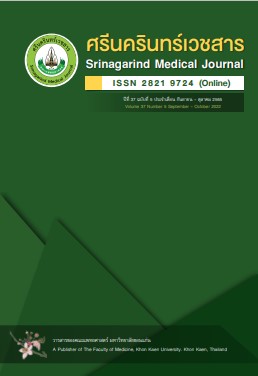Role of Klebsiella pneumoniae from Stone on Calcium Oxalate Crystal Growth and Aggregation
Keywords:
kidney stone disease, Klebsiella pneumoniae, calcium oxalate, crystal growth, crystal aggregationAbstract
Background and Objective: Klebsiella pneumoniae is a common bacterium isolated from kidney stone. It may play an important role in stone genesis. Therefore, we aimed to investigate the effects of K. pneumoniae on calcium oxalate monohydrate (COM) crystal growth and aggregation.
Methods: K. pneumoniae from stone was used to investigate the COM crystal growth and aggregation in artificial solution. The COM crystal growth and aggregation were evaluated and reported as the delta crystal area and number of crystal aggregates, respectively.
Results: K. pneumoniae can significantly increase the COM crystal growth (p<0.001) and aggregation (p<0.001) when compared to condition without K. pneumoniae.
Conclusion: K. pneumoniae could increase COM crystal growth and aggregation in vitro. However, the effects of K. pneumoniae in the different conditions on COM crystal growth and aggregates should be further investigated.
References
Nimmannit S, Malasit P, Susaengrat W, Ong-Aj-Yooth S, Vasuvattakul S, Pidetcha P. et al., Prevalence of endemic distal renal tubular acidosis and renal stone in the northeast of Thailand. Nephron 1996;72:604-10.
Sriboonlue P, Prasongwatana V, Chata K, Tungsanga K. Prevalence of upper urinary tract stone disease in a rural community of north-eastern Thailand. Br J Uro. 1992;69:240-4.
Sritippayawan S, Borvornpadungkitti S, Paemanee A, Predanon C, Susaengrat W, Chuawattana D, et al. Evidence suggesting a genetic contribution to kidney stone in northeastern Thai population. Urological Research 2009;37:141-6.
Bovornpadungkitti S, Sriboonlue P, Tavichakorntrakool R, Prasongwatana V, Suwantrai S, Predanon C, et al. Potassium, sodium and magnesium contents in skeletal muscle of renal stone-formers: a study in an area of low potassium intake. J Med Assoc Thai 2000;83:756-63.
Prasongwatana V, Tavichakorntrakool R, Sriboonlue P, Wongkham C, Bovornpadungkitti S, Premgamone A, et al. Correlation between Na, K-ATPase activity and potassium and magnesium contents in skeletal muscle of renal stone patients. Southeast Asian J Trop Med Public Health 2001;32:648-53.
Reungjui S, Prasongwatana V, Premgamone A, Tosukhowong P, Jirakulsomchok S, Sriboonlue P. Magnesium status of patients with renal stones and its effect on urinary citrate excretion. BJU Int 2002;90:635-9.
Chutipongtanate S, Thongboonkerd V. Red blood cell membrane fragments but not intact red blood cells promote calcium oxalate monohydrate crystal growth and aggregation. J Urol 2010;184:743-9.
Shahid M, Sae-ung N, Pinlaor P, Boonsiri P, Sirithanaphol W, Prasogwattana W, et al. Involvement of red blood cell on calcium oxalate crystal growth and aggregation in vitro. Arch AHS 2021;33:62-9.
Tavichakorntrakool R, Prasongwattana V, Sungkeeree S, Saisud P, Sribenjalux P, Pimratana C, et al. Extensive characterizations of bacteria isolated from catheterized urine and stone matrices in patients with nephrolithiasis. Nephrol Dial Transplant 2012;27:4125-30.
Saelee K, Tavichakorntrakool R, Amimanan P, Lulitanond A, Boonsiri P, Prasongwatana V, et al. Induction of crystal formation in artificial urine by Proteus mirabilis isolated from kidney stone patients. J Med Technol Phys Ther 2016;28:129-34.
Bichler KH, Eipper E, Naber K, Braun V, Zimmermann R, Lahme S. Urinary infection stones. Int J Antimicrob Agents 2002;19:488-98.
Miano R, Germani S, Vespasiani G. Stones and urinary tract infections. Urol Int 2007;79:32-6.
Chutipongtanate S, Sutthimethakorn S, Chiangjong W, Thongboonkerd V. Bacteria can promote calcium oxalate crystal growth and aggregation. J. Biol. Inorg. Chem 2013;18:299-308.
Khamchun S, Sueksakit K, Chaiyarit S, Thongboonkerd V. Modulatory effects of fibronectin on calcium oxalate crystallization, growth, aggregation, adhesion on renal tubular cells, and invasion through extracellular matrix. J Biol Inorg Chem 2019;24:235-46.
Chaiyarit S, Thongboonkerd V. Defining and systematic analyses of aggregation indices to evaluate degree of calcium oxalate crystal aggregation. Front Chem 2017;5:113.
Tavichakorntrakool R, Boonsiri P, Prasongwatana V, Lulitanond A, Wongkham C, Thongboonkerd V. Differential colony size, cell length, and cellular proteome of Escherichia coli isolated from urine vs. stone nidus of kidney stone patients. Clin Chim Acta 2017;466:112-9.
Amimanan P, Tavichakorntrakool R, Fong-ngern K, Sribenjalux P, Lulitanond A, Prasongwatana V. et al. Elongation factor Tu on Escherichia coli isolated from urine of kidney stone patients promotes calcium oxalate crystal growth and aggregation. Sci Rep 2017;7:2953.
Kanlaya R, Naruepantawart O, Thongboonkerd V. Flagellum is responsible for promoting effects of viable Escherichia coli on calcium oxalate crystallization, crystal growth, and crystal aggregation. Front Microbiol 2019;10:2507.
Barr-Beare, Saxena V, Hilt EE, Thomas-White K, Schober M, Li B, et al., The interaction between Enterobacteriaceae and calcium oxalate deposits. Plos One 2015;10: e0139575.
Chang, D, Sharma L, Dela Cruz CS, and Zhang D. Clinical epidemiology, risk factors, and control strategies of Klebsiella pneumoniae infection. Front Microbiol 2021;12:750662.
Janda JM and Abbott SM. The changing face of the family Enterobacteriaceae (order: "Enterobacterales"): new members, taxonomic issues, geographic expansion, and new diseases and disease syndromes. Clin Microbiol Rev 2021;34:e00174-20.
Downloads
Published
How to Cite
Issue
Section
License
Copyright (c) 2022 Srinagarind Medical Journal

This work is licensed under a Creative Commons Attribution-NonCommercial-NoDerivatives 4.0 International License.




